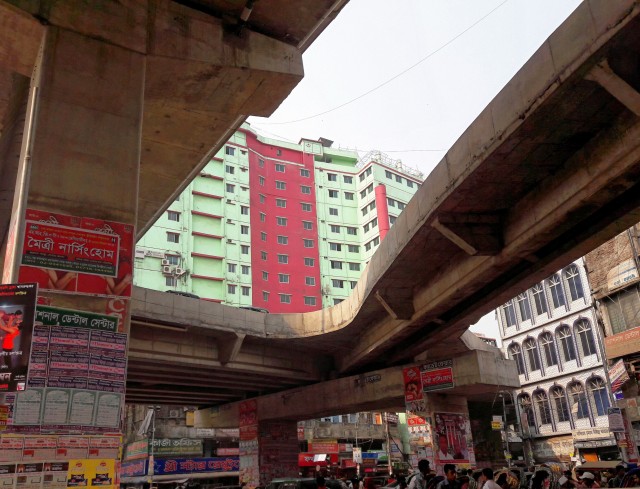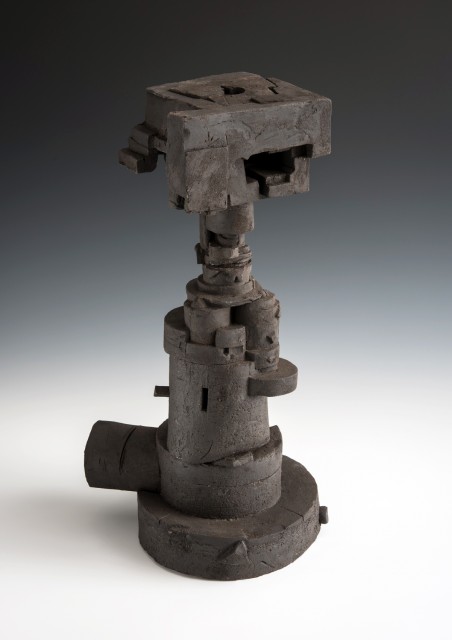Richard Crooks: Impressions From A Journey
Sculptor, traveller, ambitious teacher: artist Richard Crooks uses collage, clay and casts to respond to the contemporary architecture of Bangladesh, finds Stephen Clarke…
Situated at the border that demarcates the end of Modernism and the rise of Postmodernism, the Australian critic and art historian Terry Smith mapped out the difficulties facing those who are not at the centre of cultural production. His essay of 1974, The Provincialism Problem, discusses how artists working at the perceived periphery are subservient to the values established at the centre. At the time of his writing, New York held international dominance over other major cities London, Paris and Rome, as well as Los Angeles and Chicago, who were located as the provinces in the relationship. From New York, the waves of influence rippled out to the edges, shaping a localized correspondence.
Through most of the 20th century, Modernist art and architecture sought to challenge the values of tradition by aiming for social equality and by opposing imperialist regulation. The irony of the International Style is that while claiming universality, it mirrored the colonial spread of its predecessors. Radiating out, first from Western Europe and latterly North America, the purist tenets of Modernism determined the development of art and design across the globe.
Richard Crooks (b.1964) was educated in the principles of modernist sculpture as a student at Bath Academy of Art (1984-87) and Wimbledon School of Art in London (1989-91). His tutor and mentor at both of these art colleges was the sculptor Charles Hewlings, who had been an associate of Anthony Caro at St Martin’s School of Art. In 1988, Crooks attended the Hardingham Sculpture Workshop in Norfolk. Set up by John Foster two years earlier, it was based on the Triangle Workshops that Caro had begun in 1982. Through Hewlings and Foster, Crooks had a tangible link to the international avant-garde. This formal legacy, apparent in his early work, has provided the bedrock for his activity as a maker, but did not become the end point.
Upon completion of his studies in Fine Art, Crooks embarked on journeys to Asia. Visits to Nepal, India, Pakistan and Bangladesh have all proved key to the trajectory of his practice. His fascination with what lies outside the boundaries of Modern Art not only extended to distant lands but also to neighbouring disciplines. In 2003, Crooks undertook further postgraduate study in Ceramics at the University of Wales Institute that moved him to the “edgelands” of Fine Art and Craft. Here, he examined the cultural exchanges between China and the West through the porcelain trade after seeing artefacts of Chinese pierced porcelain on display at Cardiff’s National Museum. Predominantly working in clay, Crooks took as his motif the common English teapot. He blurred the definition of sculpture and crafted object; consequently he is at the centre of neither discourse.

From the late 1980s until recently, Crooks has been based in London where he has worked as a schoolteacher. Again, the tension between the centre and its edges becomes apparent as Crooks’ role teaching art existed at the margins of the main discourses in contemporary art practice. However, it was his position in secondary school education that gave him the opportunity to travel to Bangladesh in 2016 as part of the Rivers of the World art and education programme, and several times since 2012 as part another British Council supported project, Connecting Classrooms. These exchange programmes have enabled Crooks to form important connections with the Bangladeshi art community, in particular the Dhaka-based political cartoonist Syed Rashad Imam Tanmoy, who acts as a guide to the social and political landscape of Bangladesh. Earlier this year, Crooks returned to Bangladesh as the Bengal Foundation’s first artist-in-residence on the invitation of the Foundation’s Chief Curator, Tanzim Wahab. This appointment came out of Crooks’ earlier residency, in 2012, at Nepal’s Kathmandu Contemporary Arts Centre (KCAC) during which he produced work that responded to the stacked and tiered nature of Katmandu’s domestic and religious architecture.
A central concern in Smith’s aforementioned 1974 essay is the development of Australian art. Bangladesh, like Australia, had been part of the British Empire; only gaining full independence in 1971. Similar to Australia, its Modern art scene, from the late 19th century, would have followed London’s influence, which was itself informed by French art movements. The country’s birth coincided with Smith’s deliberation on the state of cultural dependency and national identity. Crooks’ five-week residency in Dhaka in February 2017 gave him the opportunity to explore this narrative, both in discussion and practice. Collaboration with the Bangladeshi artist Ashim Halder Sagor, and other younger artists, resulted in an open studio exhibition titled Impressions of Dhaka.

Crooks explored the landscape of Dhaka on bicycle, observing how the city had been continuously shaped by clashes of identity. The city’s existing settlement had been collaged on top of by structures such as the flyover. From the architect’s tabletop model, a new cityscape had been imposed. It is this conflicted environment that Crooks encountered on the ground. He made notes, drawings and photographs that could be taken back to the studio: direct experience informed his artwork. Reversing the process from architect’s impositions to artist’s response, Crooks’ clay sculptures act as models of the reality rather than the dictate of the removed planner. Collage has a prominent role in Crooks’ methodology as he concurrently makes “architectural” drawings that incorporate photographic cutouts. His sculptures can be read as collage as they are irregular in shape, grown from numerous architectural fragments pasted together.
Four series of sculpture and drawings come out of Richard Crooks’ residency in Dhaka: Arch, Flyover, Wedding Cake, and Intervention. This work forms the core to his solo exhibition, Impressions from a Journey, on show at The Pound arts centre in Corsham, Wiltshire. By being able to see Crooks’ drawings and photographs displayed alongside his sculptures, the gallery visitor has an opportunity to travel with the artist through his process of observation. Crooks has connected the gallery space to the outcomes from his residency in Dhaka by making an intervention with the fabric of the art centre. Casts taken from The Pound — a former Victorian school — and from the nameplate of the Bengal Foundation, the hosts of his 2017 residency, stretch into the exhibition, conceptually linking Corsham to the Bangladeshi capital.

Clearly, Richard Crooks is not a Bangladeshi artist and so his challenge as one practicing outside of the centre may be different from those artists based in Dhaka. What binds the English sculptor and his hosts is their mutual state of existence on the edges. This is a condition that is threaded through Crooks’ work as he negotiates across the borders of art and craft, of Modernist formalism and Postmodern narratives, and his own attraction to travel. Impressions from a Journey, curated by Fiona Cassidy, is a return journey for Crooks as Corsham was the home of the Bath Academy of Art where he studied in the 1980s. Whilst this exhibition does not challenge the problems of provincialism, it does highlight certain tensions. Distance from the international art centres, in this case New York and London, marginalizes art communities and results in what Smith terms “localism”. Localism asserts that significant art can be produced without observing the restraints of centralist discourse and, instead, be wholly responsive to the place of its origin. By responding to the contemporary art scene of Bangladesh, and returning to make work for exhibition in provincial England, Crooks has confounded this expectation. Making art neither at the centre nor at its outposts but somewhere in-between, the artist redefines the edges.
Stephen Clarke is an artist, writer and lecturer based in the North West.
See Richard Crooks: Impressions from a Journey until 14 October 2017 at Pound Arts at The Pound, Pound Pill, Corsham, Wiltshire
Hear Crooks discuss his recent residency at the Bengal Foundation in Dhaka, his collage and drawing process, and his cast and moulded clay sculptures — 4 October 2017 at Pound Arts, 7.30pm, £4 (free for Friends of Pound Arts)
Images from top: Dhaka flyover, collage and Early Morning Dhaka — all courtesy the artist





